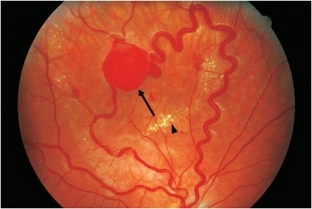The formation of cysts in parenchymal organs may be the result of a violation of the processes of embryogenesis or be hereditary. With a single cyst of any organ, they speak of a violation of the development of this organ. In the presence of cysts in several organs, we are talking about a hereditary disease. The formation of cysts (hemangioblastoma) can be in almost any organ. But the detection of hemangioblastomas in certain organs indicates a specific disease. Thus, Hippel-Lindau disease is characterized by angiomatosis of the retina and structures of the central nervous system. What is Hippel-Lindau disease, read on estet-portal.com.
Hippel's Disease – Lindau. What angiomas indicate the disease?
Hippel-Lindau disease is inherited in an autosomal fashion – dominant type. The gene responsible for the occurrence of the syndrome is located on the short arm of chromosome 3 (3p25p25). The main manifestations of the disease are retinal angiomas, hemangioblastomas of the brain and spinal cord, pheochromocytoma and renal carcinomas, and pancreatic cysts.
Hemangioblastoma – a benign formation that, as it grows, causes certain symptoms. The disease is characterized by a variety of clinical manifestations and depends on which organ is affected by the formation of a size that is sufficient for the manifestation of the disease. Angioma can be found in any vessel, but more often it is the vessels of the fundus.
Earlier, when the diagnosis was not at the same level as it is now, people with this disease barely lived to be 50 years old. Now, to the extent of the development of diagnostic procedures and the enlightenment of the population, people with this disease, with timely diagnosis of the disease and treatment, live a full life. About 90% of carriers of the gene have at least one manifestation of the disease by the age of 65.
Signs of Hippel's disease – Lindau. Reasons for the variety of symptoms
Signs of the disease depend on which organ is affected by neoplasms. In the presence of angiomatosis in the retina, which often manifests itself before the age of 25 in carriers of the gene, visual impairment is observed. When examining the fundus, angiomas can be detected.
In the presence of hemangioblastomas in the central nervous system, the symptoms can be quite varied. There is a headache, nausea, dizziness, unsteadiness when walking, impaired coordination of movements. Periodic disturbances of consciousness indicate the prescription of the process and the large size of hemangioblastomas.
In the presence of hemangioblastoma in the spinal cord, this is manifested by a violation of sensitivity, the development of paralysis. The process of defecation and urination is disturbed. Pain rarely worries patients with Hippel's disease – Lindau.
About a fifth of patients with Hippel's disease- Landau develops pheochromocytoma. Signs of the disease, if present, are manifested by high blood pressure, sweating, heart palpitations, pallor of the skin and headache.
In 10% of patients, the tumor grows in the endolymphatic sac of the inner ear, which is manifested by hearing loss, ringing in the ears, dizziness, weakness of the facial muscles, and imbalance. Such signs of Hippel's disease – Lindau is often confused with neurological pathologies.

Methods for diagnosing signs of the disease. Treatment goals for Hippel-Lindau disease
For timely detection of signs of Hippel's disease – Lindau, it is important not to miss all medical examinations. If you notice any symptoms, you should not delay going to the doctor.
Hemangioblastomas are detected during MRI of the brain. In case of accidental detection of hemangioblastomas and in the absence of symptomatic signs of the disease, they are in no hurry to remove them. Dynamic monitoring of the state and growth rate of hemanioblastoma is necessary. With progressive tumor growth and the appearance of symptoms, surgical removal of the cyst is indicated. If there are several cysts in the brain, the decision is made to remove those that cause the most severe symptoms.
The tumor is removed by microsurgery. As a rule, after surgical removal, cysts do not recur in the same place, but this does not exclude the possibility of the appearance of new hemangioblastomas of a different localization.
Thus, Hippel's Disease – Lindau is a hereditary disease, the timely detection of which does not pose a particular danger to life. Identification of signs of the disease will occur in any case if a person undergoes an annual medical examination and does an MRI of the brain. The treatment of the disease consists in symptomatic therapy, that is, the removal of hemangioblastomas if they cause symptoms.







Add a comment